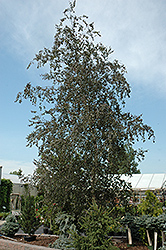Purple Rain Birch
Betula pendula 'Purple Rain'
Height: 40 feet
Spread: 25 feet
Sunlight:
![]()
![]()
Hardiness Zone: 3
Other Names: Silver Birch, Common Birch
Description:
A stunning cultivar with very deep royal purple leaves all season long, a somewhat weeping habit, and snowy-white bark; a strong accent plant, use as a solitary specimen; keep healthy and happy at all times to discourage troubles with birch borer
Ornamental Features
Purple Rain Birch is primarily valued in the landscape for its decidedly oval form. It has attractive deep purple deciduous foliage which emerges burgundy in spring. The pointy leaves are highly ornamental but do not develop any appreciable fall color. The peeling white bark is extremely showy and adds significant winter interest.
Landscape Attributes
Purple Rain Birch is a deciduous tree with a shapely oval form. Its relatively fine texture sets it apart from other landscape plants with less refined foliage.
This tree will require occasional maintenance and upkeep, and should only be pruned in summer after the leaves have fully developed, as it may 'bleed' sap if pruned in late winter or early spring. Deer don't particularly care for this plant and will usually leave it alone in favor of tastier treats. Gardeners should be aware of the following characteristic(s) that may warrant special consideration;
- Insects
Purple Rain Birch is recommended for the following landscape applications;
- Accent
- Shade
Planting & Growing
Purple Rain Birch will grow to be about 40 feet tall at maturity, with a spread of 25 feet. It has a low canopy with a typical clearance of 3 feet from the ground, and should not be planted underneath power lines. It grows at a fast rate, and under ideal conditions can be expected to live for 40 years or more.
This tree does best in full sun to partial shade. It prefers to grow in average to moist conditions, and shouldn't be allowed to dry out. It is not particular as to soil type or pH. It is somewhat tolerant of urban pollution. Consider applying a thick mulch around the root zone in winter to protect it in exposed locations or colder microclimates. This is a selected variety of a species not originally from North America.
